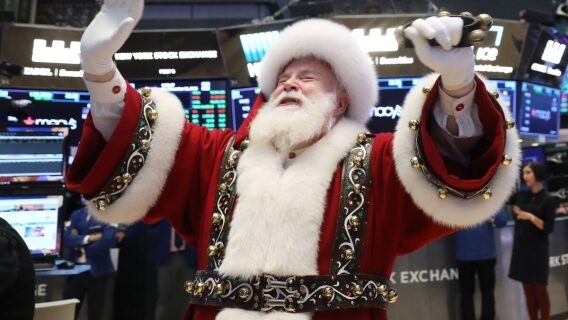Santa Claus is coming to town—and if you’re an investor, so is the Santa Claus Rally!
If you’re not familiar with the Santa Claus Rally, it’s a stock market rally that stretches between Christmas and the first two trading days of the new year. (This year, it actually starts on Christmas Eve, next Tuesday, and goes through Friday, January 3.) According to the Stock Trader’s Almanac, the Santa Claus Rally has averaged a 1.5% run-up since 1950 during those few trading days.
Theories as to what prompts investors to be in such a buying mood after Christmas range from Wall Street types investing their end-of-year bonuses, tax-related investing interests or just general holiday cheer inspiring investors to be just a little more bullish. Whatever the reason, the brief window between Christmas and the first couple of days of January is historically one of the best times to invest.
[text_ad]
What Happens When the Santa Claus Rally Fails?
Here’s the catch, though: on the rare occasions that Santa Claus delivers a lump of coal in investors’ stockings—and stocks actually fall between Christmas and the second trading day of January instead of rising—it generally portends bad things for the stock market in the year ahead. Sort of.
Since the turn of the century, it’s happened only four times, following Christmas of 2004, 2007, 2014, and 2015. And the market closed the next year in the red in only two of those instances.
For example, 2008 was preceded by a 2.5% drop in stocks during the so-called Santa Claus Rally period of 2007. As you’ll likely recall, that was a particularly tough year for the market with the Great Financial Crisis leading to a 38% decline in the S&P 500.
2014 was a different story, however, when a 3% drop during the Santa Claus Rally period preceded a minor decline of less than 1% in the subsequent calendar year.
That said, there have been significant exceptions to the theory that Santa Claus Rally fails mean bad things for the market in the year ahead. It happened the most recent time we saw red during the Santa Claus Rally period. During the last five trading days of 2015 plus the first two days in 2016, the S&P 500 tumbled 2.3%. Bad omen, right? For a while, it looked like it, as stocks continued their holiday hangover well into February.
But all three major indexes spent that year rallying to all-time highs, and the S&P was up 9.5% in 2016. So, the correlation between the Santa Claus Rally and stock performance the following year is far from foolproof.
In fact, the Santa Claus Rally gave us a green light following Christmas of 2021, and I think the less said the better about 2022, when the S&P tumbled nearly 20%.
Of course, this is all fairly tongue-in-cheek. These types of market urban legends—the Santa Claus Rally, the January Effect, Sell in May and Go Away—are good fodder for columns like this one. And though the numbers may support a connection between an end-of-year rally meaning good things for stocks the following year (and the absence of a Santa Claus Rally meaning bad things), I don’t think the correlation is anything more than a coincidence.
What Really Matters for 2025: Momentum
Sure, it makes sense that a bad end to one calendar year can spill over to the beginning of the next year, which is exactly what happened in 2015-16. But that only lasts about a month. By February, investors don’t really care (or, more likely, have long forgotten) about whether Santa Claus stuffed himself down Wall Street’s chimney or not—especially in today’s jam-packed 24-hour news cycle.
So, if Santa Claus does deliver another nice 1.5% return (or thereabouts) after Christmas, just try and profit from it in the moment by finding great growth stocks or hot momentum stocks like the ones our Mike Cintolo offers up weekly to his Cabot Top Ten Trader subscribers. But don’t get too caught up in what five trading days mean for 2025.
[author_ad]

